This Homemade English Muffins recipe is cooked on a skillet and makes fluffy English Muffins full of the signature nooks and crannies we love.

Table of Contents
- My Homemade English Muffins Recipe!
- What Are English Muffins?
- Recipe Ingredients
- How to Make English Muffins
- Why Buttermilk?
- What Happens If Your English Muffins Brown Too Quickly In Your Skillet?
- Tips for the Best English Muffins
- How To Fork Split An English Muffin
- Here’s How To Split An English Muffin:
- Serving Ideas
- How to Store English Muffins
- Get the Recipe
My Homemade English Muffins Recipe!
When you’ve got four kids, you become a pro at quick and easy meals. Back in the day, I found myself going through loads of store bought English muffins because they make for a yummy, filling, and deliciously easy breakfast. Simply toast them and slather them up with butter and jam. Or, turn them into a breakfast sandwich with a fried egg and sausage patty. At dinnertime, well, my family is all about English muffin pizzas.
It wasn’t long before I realized I’d have some major savings by making my English muffins at home! But, I psyched myself out. They’ve got to be hard to make, right? Wrong! They are so easy to make. They are lightly kneaded, only rise once, AND you won’t even need to turn on your oven.
What Are English Muffins?
When you think of English muffins, I’d bet you picture the signature nooks and crannies. I could just drool thinking about melted butter pooling in the large nooks and crannies. I bet you can, now, too. Are you picturing it? But, aside from nooks and crannies, what makes an English muffin an English muffin? Well, they’re not made in a cupcake or muffin tin. That’s it, really.
If you go to England, they’re simply called muffins. And, what we call muffins are called American muffins or sweet muffins. Weird, right?!?
Recipe Ingredients
Don’t let these English muffins fool you! Aside from buttermilk and yeast, I’ll bet you’ve got everything you need at home right now!
- Buttermilk
- Butter
- Bread flour
- Instant Yeast
- Salt
- Sugar
- Egg
- Corn meal

How to Make English Muffins
- Melt: In a microwave safe bowl heat the buttermilk and butter together in 30- second increments until the buttermilk is warm, reaching a temperature of 120°F – 130°F on an instant read thermometer. The buttermilk might separate and look curdled. Don’t worry, this is okay.
- Mix: Add the flour, yeast, salt, sugar, and egg into the bowl of your stand mixer fitted with the paddle attachment. Pour in the buttermilk mixture and mix on low until combined. This should take about 1 minute.
- Remove the paddle attachment and replace it with the dough hook attachment. Turn mixer up to medium-high and mix for 5 minutes, until the dough is smooth and elastic.
- If you don’t have a dough hook attachment, you can knead the dough by hand on a lightly floured surface for 5-6 minutes. It will take about the same amount of time and you know your dough is ready when it’s smooth, elastic and bounces back when pressed lightly with 2 fingers.
- Rise: Form the dough into a ball, and cover the bowl with a towel. Place the bowl in a warm, draft free place in your kitchen and allow the dough to double in size. This will take 1-2 hours, depending on the warmth of your kitchen. If your oven has a proof setting, this can be used as well.
- Prep: Prepare a large baking pan by sprinkling it liberally with corn meal. Once you’ve done this, set the pan aside.
- Divide: Once the dough has doubled in size, remove it from the bowl and divide it into 16 pieces. Roll each piece into a ball and flatten the ball until it’s about 3- inches in diameter. Place each into the prepared pan. Sprinkle the tops of the muffins with more corn meal. Cover the pan and let the dough rest for 20 minutes.
- Heat: Spray a griddle or large skillet lightly with nonstick spray, or coat it lightly with oil. Heat the pan on low and place the muffins onto the pan, working in batches, carefully transferring the muffins onto the griddle. You don’t want to handle them too much. This will cause them to deflate.
- Cook: Cook the muffins on each side for 7-10 minutes, until the crust on each side is golden brown and the center of the muffin reaches 180°F on an instant-read thermometer.
- If you don’t have an instant read thermometer, don’t stress! If your muffins cook in the skillet for 7-10 minutes on each side and are golden brown, they are pretty much guaranteed to be cooked.
- If the muffins are browning too quickly, place them in a 325°F oven on a parchment lined pan for 10 minutes, or until cooked thoroughly. Depending on the pan you use, this can happen and is not a problem at all!
- Cool: Allow the muffins to cool completely on a wire rack before using a fork to split them.

Why Buttermilk?
I get – hands down – the best English muffins using buttermilk. I’ve tried alllll the other options: whole milk, 2% milk, combinations of milk and water. Take it from me, buttermilk gets the best results.
I really like the texture and flavor that buttermilk adds to my English muffins. The acidity in the buttermilk works really well with the yeast to rise and create a nice, airy dough. This is what gives my homemade English muffins the signature nooks and crannies we all love Don’t worry if you don’t have buttermilk. You can quickly and easily make a buttermilk substitute right at home!
What Happens If Your English Muffins Brown Too Quickly In Your Skillet?
If the muffins are browning too quickly, don’t panic! Depending on the pan you use, this can happen and is not a problem at all! Simply, place them in a 325°F oven on a parchment lined pan for 10 minutes, or until cooked thoroughly.
This can happen for loads of different reasons, but these are the most common:
- A dark pan like a cast iron skillet distributes and holds heat, which can lead to it getting too hot too quickly.
- Stove tops can heat on low at different temperatures. You might have an electric stove top, or a gas stove top…there’s no set temperature for “low” and temperatures may vary.
- If you’re working in batches, your skillet will be hotter on the second or third batch than the first, creating varying cook times.
Tips for the Best English Muffins
If you’re looking for my top tips for the best English muffins, I’ve got you, girl. Here are my suggestions:
- Allow the dough to rise to at least double in size. If the dough isn’t rising, just give it more time, and make sure it’s in a warm, draft-free place in your kitchen.
- Does your oven have a proof setting? If yes, this works great with this dough.
- Let that dough rest. Once you’ve allowed your dough to rest for 20- minutes after you’ve formed them into flattened balls try not to handle them too much. They will rise slightly and this is when all the air pockets form giving you the distinct interior texture of an English Muffin.
- Both kinds of yeast work. You can use regular yeast instead of instant yeast, you just need to give it more time to rise!
- If your English Muffins are browning too quickly on the stove top, just place them on a parchment lined baking sheet in a 325°F oven for 10 minutes to bake them.
How To Fork Split An English Muffin
Please! Never cut an English muffin with a knife! When you do this, you lose all of the nooks and crannies. Instead, you should ALWAYS fork split your English muffins.
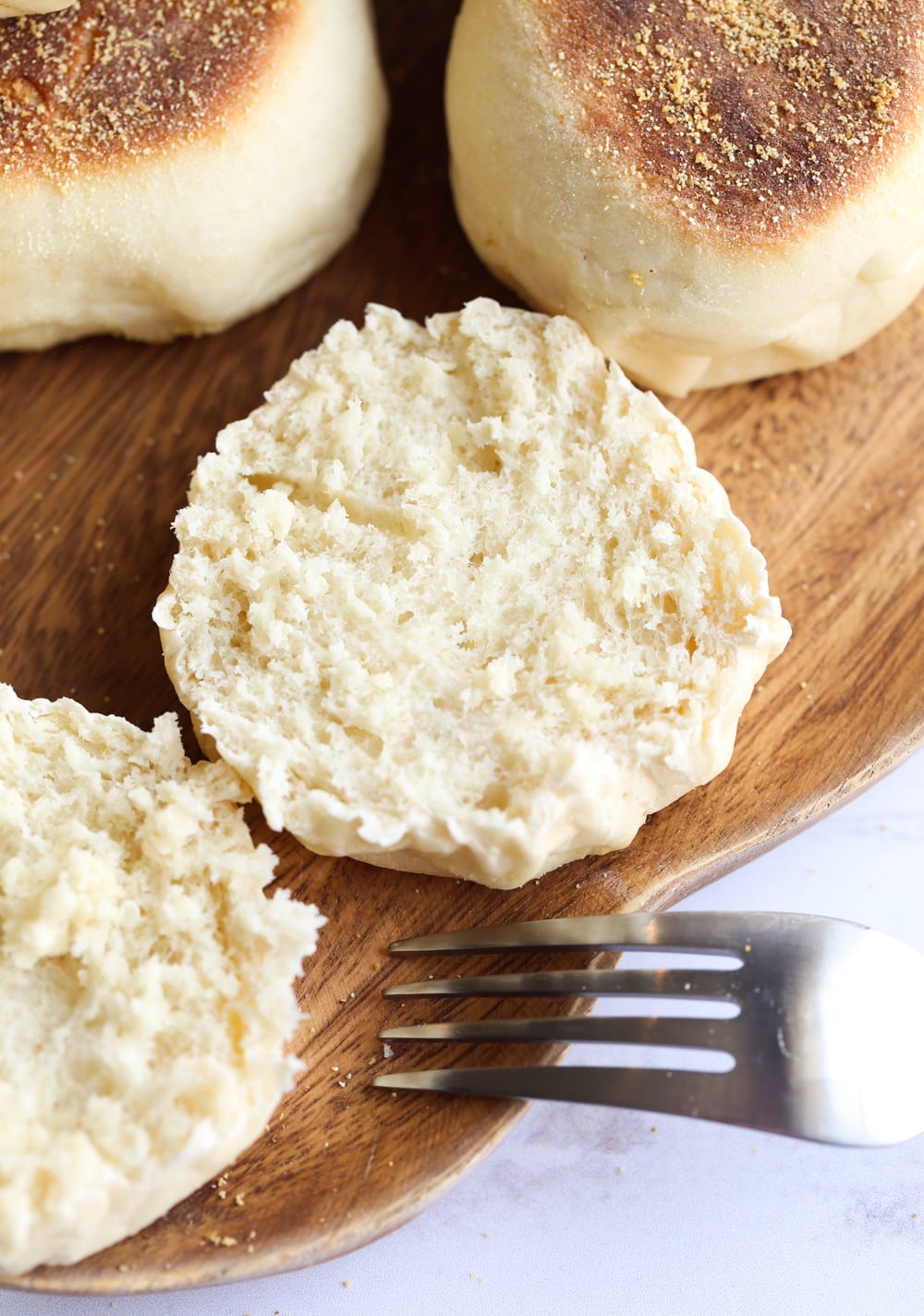
Here’s How To Split An English Muffin:
- Hold your English muffin in one hand and your fork in the other hand.
- Insert your fork into the side of the English muffin.
- Spin your English muffin while simultaneously moving your fork in and out until it arrives back at the place you started.
- The two sides should completely separate.
Serving Ideas
- English muffins make for a great breakfast. They’re super simple to toast and serve with butter or jam. You can also use them as the bread on your breakfast sandwich – egg and cheese; egg, cheese, and bacon; egg, cheese, and sausage – on an English muffin. Scrambled eggs, over easy eggs, I’ve even been known to sandwich an omelette filled with cheese between two slices of English muffin. YUM!
- My kids have always enjoyed them as mini pizzas, too. All you have to do is fork split them, spoon on your favorite sauce, and top with shredded mozzarella. Then pop them in the oven until toasted and the cheese is melted.
- You could use your English muffins as the bread for any sandwich, really. Peanut butter and jelly? Sure! BBQ pulled pork? Yep! Burger?
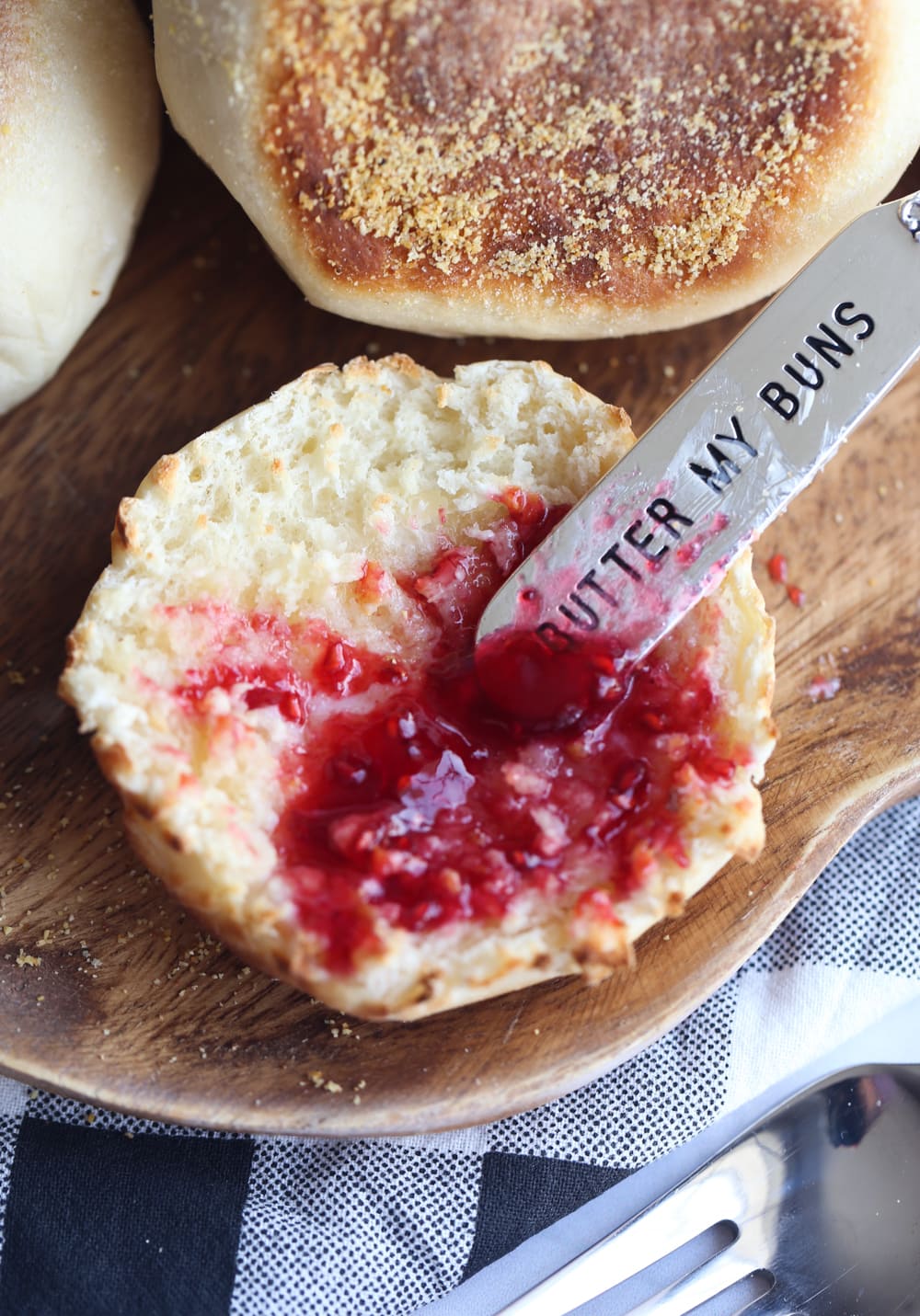
How to Store English Muffins
Now, it’s not likely that I’ll eat 16 English muffins in one sitting. Hey, I said it’s not likely, but it’s definitely not impossible.
If you do end up needing to store your English muffins, you have two options. First, you can store them in an airtight container at room temperature for 3 days.
Or, you can freeze your leftover English muffins in a ziptop bag for 30 days. Don’t forget to label your freezer bag so you are sure when to use them. Allow them to thaw to room temperature before using them.
Print
English Muffins
- Prep Time: 3 hours
- Cook Time: 10 minutes
- Total Time: 3 hours 10 minutes
- Yield: 16 English Muffins
- Category: Bread
- Method: Oven
- Cuisine: English
Description
Making English Muffins at home is so rewarding…and delicious! This easy English Muffins recipe will have you enjoying homemade muffins in no time.
Ingredients
- 1 3/4 cups buttermilk
- 1/4 cup butter, cubed
- 4 1/2 cups bread flour
- 1 (0.25- ounce) packet Instant Yeast (2 teaspoons)
- 1 teaspoon kosher salt
- 2 tablespoons granulated sugar
- 1 large egg, lightly whisked
- Corn Meal for sprinkling on pan
Instructions
- In a microwave safe bowl heat the buttermilk and butter together in 30- second increments until buttermilk is warm, reaching a temperature of 120°F – 130°F on an instant read thermometer. Buttermilk might separate and look curdled. This is ok.
- Add the flour, yeast, salt, sugar, and egg into the bowl of your stand mixer fitted with the paddle attachment. Pour in the buttermilk mixture and mix on low for 1 minute until combined. Remove the paddle attachment, replacing it with the dough hook attachment. Turn mixer up to medium-high and mix for 5 minutes, until the dough is smooth and elastic. Alternately, you can knead the dough by hand on a lightly floured surface for 5-6 minutes.
- Form the dough into a ball, and cover the bowl with a towel. Place the bowl in a warm, draft free place in your kitchen and allow the dough to double in size. This will take 1-2 hours, depending on the warmth of your kitchen. If your oven has a proof setting, this can be used as well.
- Prep a large baking pan by sprinkling it liberally with corn meal. Set aside.
- Once the dough is doubled, remove it from the bowl and divide it into 16 pieces. Roll each piece into a ball and flatten the ball until it’s 3- inches in diameter. Place each into the prepared pan. Sprinkle the tops of the muffins with more corn meal. Cover the pan and let the dough rest for 20 minutes.
- Spray a griddle or large skillet lightly with nonstick spray, or coat lightly with oil. Heat the pan on low and place muffins onto pan, working in batches, carefully transferring the muffins onto the griddle. You don’t want to handle them too much, causing them to deflate.
- Cook the muffins on each side for 7-10 minutes, until the crust on each side is golden brown and the center of the muffin reaches 180°F on an instant-read thermometer. If the muffins are browning too quickly, place them in a 325°F oven on a parchment lined pan for 10 minutes, or until cooked thoroughly. Depending on the pan you use, this can happen and is not a problem at all!
- Allow the muffins to cool completely on a wire rack before using a fork to split them.
Notes
Store airtight at room temperature for up to 3 days. Freeze in a zip-top bag for up to 30 days. Allow English Muffins to thaw at room temperature.
Here’s the link to my Buttermilk Substitute in case you’re all out!
Nutrition
- Serving Size: 1 muffin
- Calories: 200
- Sugar: 3 g
- Sodium: 179.4 mg
- Fat: 4.8 g
- Carbohydrates: 32.4 g
- Protein: 6.2 g
- Cholesterol: 22.2 mg
Want To Save This Recipe?
Find more recipes like this:
PIN for later:
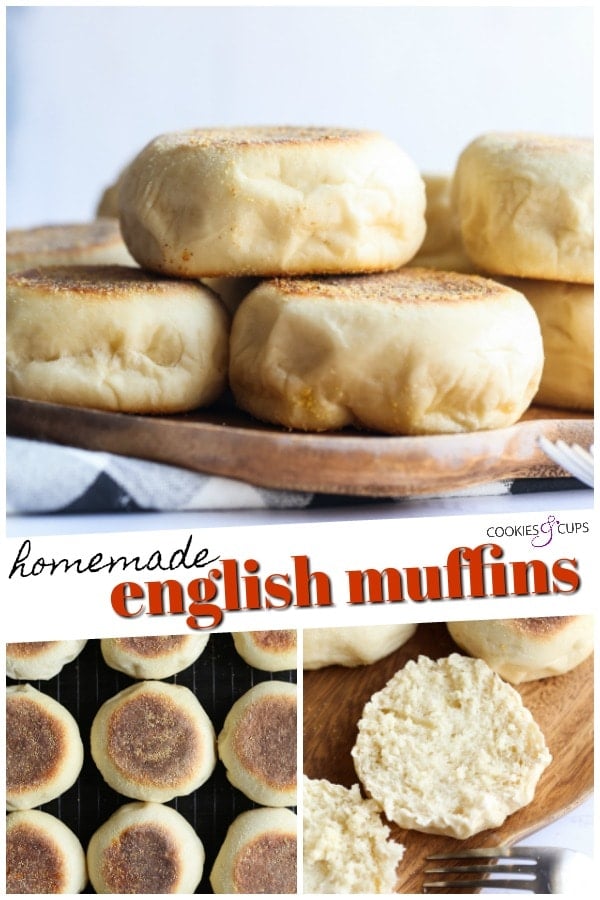

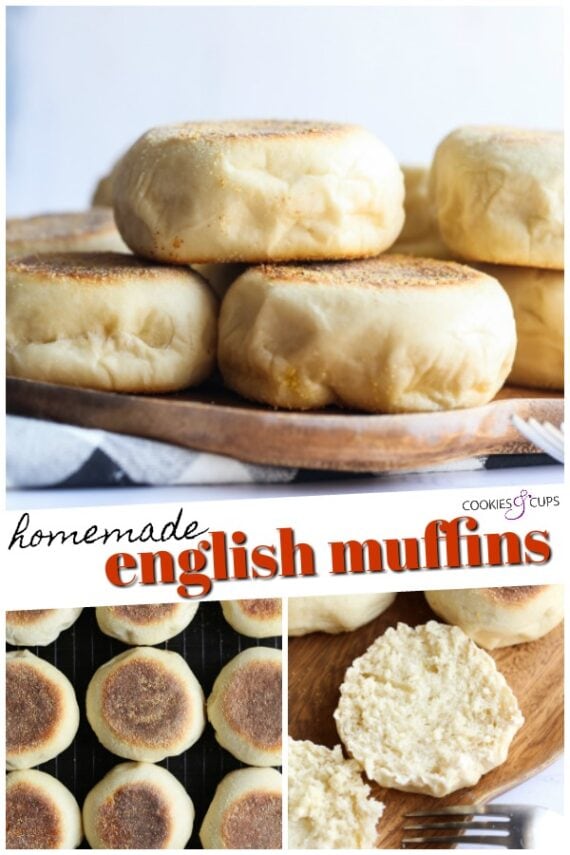



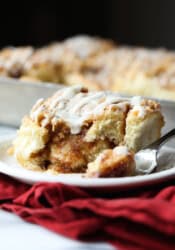

















Can you use Active Dry Yeast for this recipe?
Hi.
Where can i find this funny knife that reads “butter my buns” you use in one photo where you put the yam on the buns ?
….pleace tell us!!! we just have to know?
Oh I wish I could share! It was a gift, but I think they purchased it on Etsy!
Just made these today..holy wow, they are fantastic!
Damnit women! You have done it again!
Five stars as per your usual amazing recipes deserve!
I did have to add extra flour little over a 1/4 cup of flour to get it to smooth out. Could be because I’m in NC, it might be a bit more humid.
Thank you again for another delicious recipe!
My husband said he’d actually eat English muffins from the store if they tasted like that. He ate 2 right before dinner, lol.
English muffins are our aunts favorite! She loved them.
Keep doing what you do you amazing chef!!!
Oh I LOVE hearing this!!! I worked on this recipe for a while to get it right, so this makes me so happy!
Can you just use regular flour? I don’t have bread flour on hand.
You can, bread flour has a higher protein content which produces more gluten, giving them the chewy bread texture, so that is ideal. All purpose flour will work, they will just have a slightly different texture!
This was an easy to follow recipe! The results were fantastic. I used my electric griddle on 250. It definitely has hot spots so some cooked quicker than others. I moved them around on the griddle. Testing the internal temperature was a perfect way to know if these were done! Thanks Shelly!
My dough is on its first rise and is sooo runny… Definitely no “forming a ball” possible ? I know I measured everything correctly! So I’m just gonna to hope it firms up a bit as it rises. We love English muffins!
The dough definitely shouldn’t be runny… it will be thick and form a ball easily. I would definitely add more flour.
My 14 year old is making them now. Will let you know how they turn out! We can’t wait – you had us at buttery, nooks and crannies!
Can any part of this be done in a bread maker? They look wonderful!
I can’t speak to how the dough would work in a bread maker…but I would imagine you could do it up until you divide the dough. Haven’t used a bread maker in years!
My daughter is celiac, will gluten free flour work?
I have never made these with gluten free flour, so I would be very interested to see how the texture came out!